Click here to suggest a topic using Skribit. Search past articles here.
After mauling almost every other asset class, industry, and sector, the bear is now stretching out its paws for a swig of crude oil; crude oil is now down 19.9% from its high just last month. "Everyone" eagerly awaits the official pronouncement so that we can declare that justice has been served for all the pain high oil prices have caused us. It is interesting how we look for buying opportunities and bottoms after 20% declines in the stock market, but for oil and other commodities, we just look for lower and lower prices. Call it the curse of the high prices no one wants. There may be a just a touch of irony in the rapid correction in oil prices just as the U.S. presidential candidates are calling high oil prices America's biggest crisis. Meanwhile, our national debt refuses to undergo its own correction and just goes ever higher. Now, of course, high commodity prices are part of the problem. For example, Boone Pickens claims that the U.S. will send $700B overseas to pay for oil this year and perhaps as much as $10 trillion over the next 10 years. Americans are borrowing to pay a good portion of that bill using depreciating dollars. These loans are increasingly imported from overseas. Unfortunately, it seems the savings from commodity deflation are being earmarked for more consumption - at least this is the stated hope of those pundits looking for a quick turn-around in U.S. economic growth. All this to say that I recommend checking out an independent film called I.O.U.S.A.: "One Nation. Under Stress. In Debt."...
(Thanks to Trader Mike for pointing this one out to me!)
Yes, that was a naked plug and segue, but I feel that America's growing indebtedness simply does not get enough attention even though its malignant growth is intertwined with the commodity story.
Anyway, back to the commodities themselves. The past few missives, I have included a few notes about the sell-off in commodities but never posted any charts, including one missive where I talked about the accumulation of shorts in the USO just as oil was peaking. I finally want to spend a little time on the commodity-related stocks that I often track. The July 2nd sell-off in so many commodity stocks was dramatic, but I am finding the fades after earnings to be even more telling...especially after the CEOs of these companies insist that the commodity bull remains healthy and strong and global growth is as robust as ever.
By now, you all have heard that July was the 2nd worst month on record for the CRB Commodities index. But it is all too easy to forget that this tremendous drop came immediately on the heels of the best first 6 months of a year for this very same index since 1973! So, all we might have is an extremely volatile basket of goods and not a dramatic correction underway. Time will tell. I have become accustomed to hearing calls for the end to the commodity bull throughout the last several years or so. Each time, the planet has decided it still cannot get enough. These latest huge moves mean "something," but we likely will not know what that something is until we get the benefit of hindsight. I personally am watching for signs that the global growth story is unwinding (all those international companies who proudly announce that their U.S. business holds an insignificant share may come to regret their global over-weighting by next year!?!).
Let's take a look at Bucyrus (BUCY), Arch Coal (ACI), U.S. Steel (X), and Dryships (DRYS).
Earnings call quotes from BUCY on July 25th (from Seeking Alpha): "High demand for our products and services continues to be driven by high international commodity prices and strong markets for commodities that are mined by our machines, including coal, copper, iron ore and oil sands." "Market indications have not abated it whatsoever. I think you see some of the things that have kind of created some noise in the marketplace here in our industry in the last couple of weeks. But there has been absolutely nothing to slow down the pace of activity that we have got in the marketplace right now."
The market got religion again on BUCY after comments like that, sending the stock up 15% that earnings report. BUCY gained a full 28% before giving it all back, and then some, and now sits right back where it started before earnings. I bought in yesterday on the expectation that if commodities do recover soon, BUCY will relaunch.
(Color code for text on all charts: red for a "bad sign", yellow for "caution", green for a "good sign")
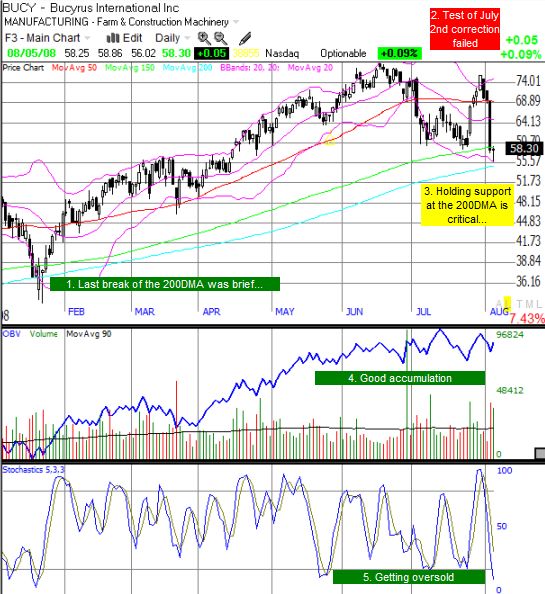
Earnings call quotes from ACI on July 25, 2008 (from Seeking Alpha): "we would argue the fundamentals have gotten stronger as we've seen it from a supply demand basis over the last three weeks, the last quarter from a quarter ago and then which you might see in just the trading in the couple of financial coal market."
Just as in BUCY's case, the market got religion and sent ACI hurtling back upward, but unlike BUCY the stock price never even touched the July 2nd correction levels. ACI essentially confirmed a short-term downtrend. ACI is now 10% below its pre-earnings price, well-below the 2006 highs again (around $56/share), and it is flat overall for the year. For you technicians, the pullback from the earnings pop confirmed a very bearish-looking head & shoulders top. All very ominous.
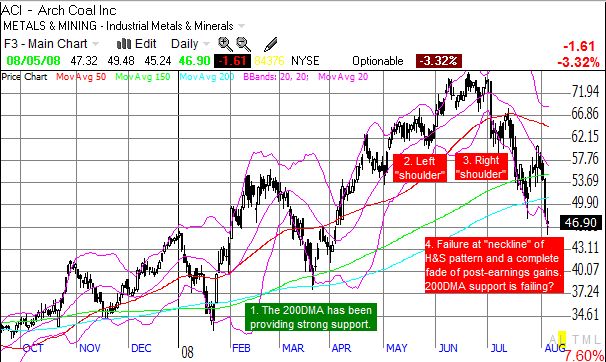
Earnings call quotes from NUE on July 17, 2008 (from Seeking Alpha): "we've obviously seen a record price increases in steel as I've said and we don't have the ability to cover our backlogs with the inventory. So we're always trying in these times just like in 2004. We're certainly attempting to very aggressively get our prices up because we know the higher steel prices are going to flow to us, that's number one." "if stock is down as much as you [say it is], I would argue...there is an excellent buying opportunity." "...the direction of pricing is not flat, it's not down, it's up. And with the global demand for our products, the way it's been and the lack of imports, we are just in that direct, as I said before many times, we are in a direct opposite condition we were in 1999 and 2000, where we had great demand and lousy profits, because the world was flooding our shores with excess steel. Today, we have just the opposite of that. And demand is good globally; raw material prices as a result have gone up. And we have been able to have pricing power and we see that continuing into the third quarter..."
NUE dropped 11% after its earnings and has not recovered since. It is now down for the year again and back to 2006 prices. The stock price was hurt by a dilutive stock offering at $74 that sure looks very shrewd on NUE's part. During the conference call, several analysts practically begged NUE to buyback stock since a buyback must offer a much better return on cash than any other investment or acquisition NUE could do. I imagine the stock will continue to experience strong overhang until the company makes a move with all that cash on its books. I show the long-term monthly chart below to emphasize that NUE's two years of churn follow a tremendous four-year run. This run was a break-out from nine years of doing almost nothing. A break of 2006 and 2007 lows may initiate another extended period of non-performance. If those lows hold, I want to put NUE at the top of my shopping list of commodity-related stocks.
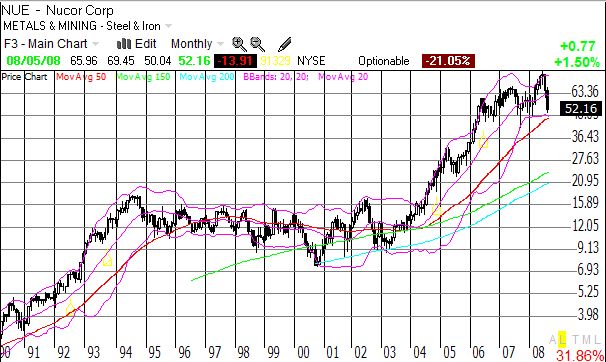
U.S. Steel (X) also faded hard after a nice post-earnings return (14%). It has now twice made inroads into the July 2nd sell-off and failed. If support from the past two days can hold, X might get on the buy list. However, X will not return to a bullish position until it conquers overhead resistance at $170.
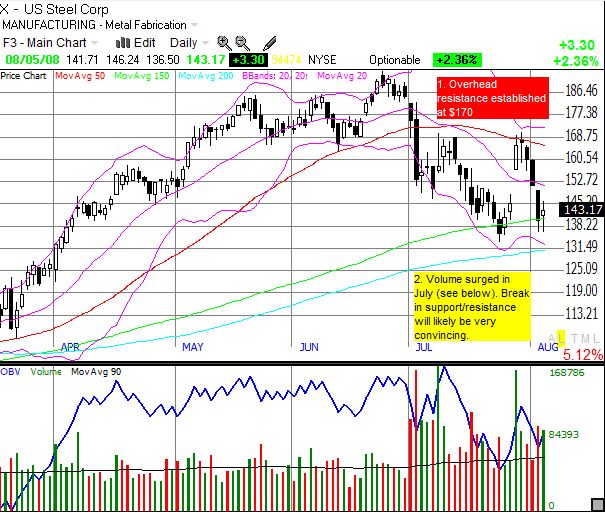
The price index for dry bulk shipping has been plummeting over the past month. Folks can quickly point to this as a sign that the global economy is grinding to a halt. However, during this time, the stock prices of these shippers has been idling. This week, those stocks have finally started to fall out of their comfortable, low-volume, "congestion" areas. Before this week, it was looking like the decline in shipping rates had already been priced into the stocks. Follow-through on the selling could be a true warning signal for the robustness of global trade. I show the chart of Dryships (DRYS) as an example of what is happening. Charts of Excel Maritime Carriers (EXM) and TBS International (TBSI) look similar although recent selling has been even more pronounced for these two.
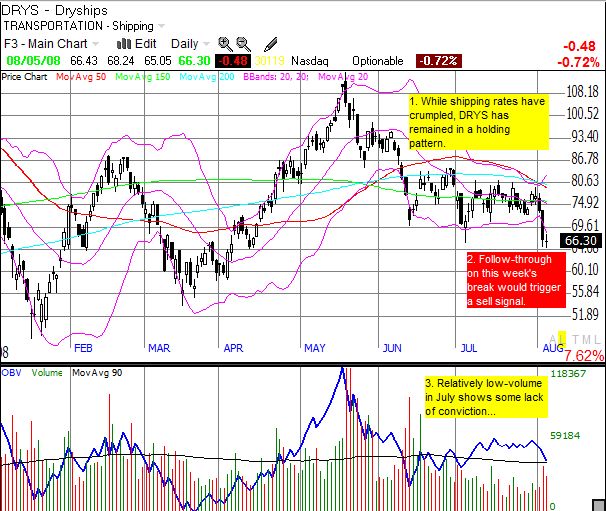
These are just a few examples of many that demonstrate the recent break-down in commodity-related stocks. I did not even include any examples from the agriculture complex or commodity-related infrastructure companies. In many cases, long-term uptrends remain intact and overall, bear or no bear, it seems too early (again) to call an end to the commodity boom.
Full disclosure: Long BUCY. For other disclaimers click here.